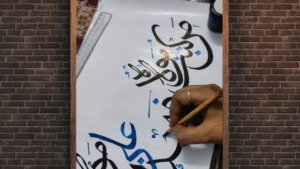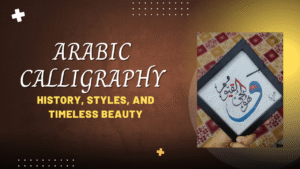In a fast-paced and modern world, where distractions are endless, there’s something profoundly grounding about returning to one’s roots—through faith, stillness, and sacred expression. The Art of Devotion goes beyond rituals; it is the soul’s journey through faith, creativity, and intentional beauty. It encompasses everything from spiritual art to mindful living, offering a path to divine connection through intentional acts, prayer, and sacred design.
Whether expressed in Islamic calligraphy, devotional music, prayer spaces, or acts of service, the art of devotion speaks to the core of who we are. It’s not just what we believe—it’s how we live, create, and connect with something greater than ourselves.
Understanding the Art of Devotion
The Art of Devotion refers to the creative and intentional ways humans express their love, reverence, and surrender to the divine. It is an art form in itself—because it requires presence, mindfulness, dedication, and often beauty.
This devotion can take many forms:
- Visual arts like Arabic calligraphy, mandalas, sacred geometry
- Spiritual practices such as prayer, fasting, and meditation
- Creating sacred spaces that reflect inner peace and divine remembrance
- Everyday acts done with intention, like helping others or caring for the self with dignity
The beauty of the art of devotion lies in its universality—you can find it in every faith, every culture, every heart that seeks something higher.
The Art of Devotion in Islamic Culture
In Islamic tradition, devotion is both deeply personal and widely expressed through sacred aesthetics. From the way one performs Salah (prayer) to the breathtaking architecture of mosques, Islam has nurtured the art of devotion across centuries.
### 1. Arabic Calligraphy: Writing the Divine
Arabic calligraphy is one of the purest visual expressions of devotion in Islam. It involves inscribing verses from the Quran, Hadith, or names of Allah and the Prophet ﷺ in beautifully structured styles like:
- Thuluth
- Naskh
- Diwani
- Kufic
These forms are not just decorative—they are a spiritual practice in themselves. Writing or viewing calligraphy becomes a way to reflect on the meanings, to immerse in divine remembrance (Dhikr), and to adorn one’s space with sacred art.
At Harfaura, for instance, artists blend the art of devotion with modern aesthetics, creating elegant Arabic calligraphy for walls that turn homes into sanctuaries.
### 2. Mosque Architecture: A Devotional Masterpiece
Mosques across the world—from the Blue Mosque in Istanbul to Masjid Al-Haram in Makkah—show how devotion is embedded into design. The domes, minarets, symmetry, and detailed tile work represent a visual surrender to divine beauty.
The use of geometry and proportion mirrors the eternal order of Allah’s creation. This is devotion turned into form—a reminder that worship exists even in space and structure.
Creating Sacred Spaces: Devotion in Daily Life
The art of devotion doesn’t have to be grand. It can be expressed in your room, office, or heart. Creating sacred spaces that encourage stillness, reflection, and connection is part of this art.
How to bring devotion into your space:
- Add Arabic calligraphy wall art with verses or names of Allah
- Use a prayer mat that feels personal and peaceful
- Light candles or use soft lighting to create calmness
- Keep the Quran or other spiritual texts accessible
- Declutter the space to promote focus and simplicity
When your surroundings reflect peace and purpose, your spirit naturally aligns with devotion.

The Role of Intention in the Art of Devotion
The Prophet Muhammad ﷺ said: “Actions are judged by intentions.” (Bukhari & Muslim)
This Hadith perfectly captures the essence of the art of devotion. You could be painting a canvas, making tea for your family, or walking in silence—but when done with the intention to serve, reflect, or connect to Allah, it becomes sacred.
Devotion is not about perfection; it’s about presence.
- Writing “Bismillah” before tasks adds barakah (blessing)
- Helping someone in need becomes a form of worship
- Decorating your home with Quranic art turns your walls into dhikr (remembrance)
This is where art and life merge—devotion becomes a lifestyle, not a moment.
Devotion in Art and Creativity
All creativity stems from the Divine. When artists, writers, and designers dedicate their work to higher meaning, their art becomes a reflection of divine truth.
Examples of devotional art:
- Islamic wall hangings with calligraphy of Ayat-ul-Kursi or Surah Al-Ikhlas
- Jewelry with Allah’s names
- Books, poetry, and digital prints inspired by the Quran or Hadith
- Nasheeds and recitations created with love and intention
The art of devotion is also found in handmade items—like the calligraphy pieces sold by Harfaura, which connect craftsmanship with faith and healing.
Daily Practices That Nurture Devotion
Incorporating devotion into your everyday life doesn’t require anything elaborate. Here’s how you can practice the art of devotion daily:
### 1. Morning Reflection
Begin your day with gratitude and remembrance. Even five minutes of Quran reading or silent dhikr brings the heart into alignment.
### 2. Mindful Prayer
Perform Salah not just as a duty, but as a sacred pause to reconnect. Focus on the meanings of the verses.
### 3. Journaling Devotional Thoughts
Write about what you’re thankful for, a Hadith that moved you, or how Allah showed up in your life that day.
### 4. Creative Devotion
Paint, write, or create something for the sake of Allah—even if only you see it.
The Connection Between Beauty and Devotion
In Islam, beauty itself is sacred. The Prophet ﷺ said: “Indeed, Allah is beautiful and He loves beauty.” (Muslim)
So when your art, your home, your actions, or your heart reflect beauty with intention—it becomes an act of worship.
The art of devotion thrives in beauty. That’s why sacred aesthetics, like those created by Harfaura, are so meaningful. They aren’t just decor—they’re devotion on display.
FAQs About the Art of Devotion
Q1: What is meant by the art of devotion?
It means expressing one’s spiritual love and reverence through intentional acts, art, and practices. It combines creativity, purpose, and faith.
Q2: How is devotion shown in Islamic art?
Islamic art uses Arabic calligraphy, geometric patterns, and architecture to express devotion visually. It avoids figural forms and focuses on spiritual symbolism.
Q3: Can art be a form of worship?
Yes—if created with sincere intention, art can reflect divine truth, encourage dhikr (remembrance), and inspire others spiritually.
Q4: How can I bring the art of devotion into my home?
Use calligraphy wall art, keep your space clean and calm, add reminders of Allah (like tasbih, books, or verses), and dedicate areas for prayer and reflection.
Q5: Is devotion only about religion?
While devotion is deeply spiritual, it can also be expressed through kindness, service, and creativity when done with higher intention.
Conclusion: Devotion Is the Most Beautiful Art
In the end, the art of devotion is not just found in galleries, masjids, or books. It is written in the way we live, create, and remember our Creator. Whether you paint a verse, decorate with sacred art, serve your loved ones with kindness, or simply pray with your heart full—it is all devotion.
In a world of noise, devotion is stillness. In a world of distraction, devotion is clarity. In a world of fleeting trends, devotion is eternal.
Let the art of devotion not just decorate your space—but transform your life.


